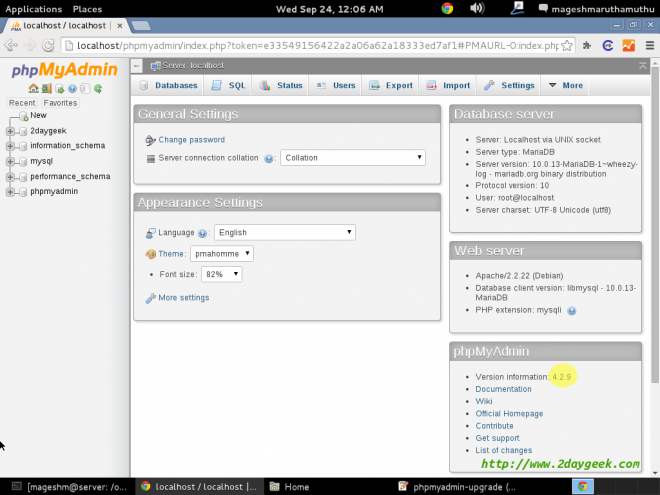
:max_bytes(150000):strip_icc()/phpmyadmin5-5c06dd2ac9e77c0001101f03.jpg)
- Launch phpmyadmin ubuntu how to#
- Launch phpmyadmin ubuntu install#
- Launch phpmyadmin ubuntu software#
- Launch phpmyadmin ubuntu password#
- Launch phpmyadmin ubuntu windows#
Launch phpmyadmin ubuntu software#
The installation process is also pretty straightforward in both server environments.įor WAMP, after downloading the zip folder containing the WordPress software and configuration files, you'll need to extract the WordPress files in your server's root folder, named WordPress in WAMPĪfter exporting the WordPress files to your server's root, you can now run WordPress locally on WAMP. PHPMyAdmin on localhost Installing WordPress on WAMP and XAMPP serversīoth WAMP and XAMPP make it easy to run WordPress sites on your local server. There, you'll be prompted to log in with your database username and password, which by default are root and blank respectively. If phpMyAdmin is selected and subsequently installed, you can access it by starting up Apache and MySQL on whichever of the two stacks you're using and navigating to in your web browser.

In fact, it's included in the default installation for WAMP: Installing WAMP Both are simple, lightweight Apache distributions that make it very easy for developers to create a local web server for testing purposes.ĭuring the setup process for both WAMP and XAMPP, when selecting the server components to install, you'll be given the option to include phpMyAdmin. X means any operating system), Apache, MySQL, PHP, and Perl.
Launch phpmyadmin ubuntu windows#
The WAMPServer software installs and configures the WAMP stack, which entails all three of Apache, MySQL (plus MariaDB), and PHP running on a Windows operating system. Two popular solution stacks in this category are WAMP and XAMPP. Today, there are several open-source PHP servers, also known as server solution stacks, which come with the components needed to create a local Apache web server, saving us the hassle of installing and configuring everything by ourselves. Installing phpMyAdmin With WAMP and XAMPP Htpasswd -c /etc/htpasswd/.htpasswd usernameīrowse to your PMA site, and you'll be prompted for your username and password, as shown above. Make a directory to store your passwords: mkdir /etc/htpasswdĪdd htaccess support for PMA: nano /etc/phpmyadmin/nfĬonfigure your user authentication for PMA: nano /usr/share/phpmyadmin/.htaccess AuthType Basic
Launch phpmyadmin ubuntu install#
Install htpasswd as part of apache2-utils: apt-get install apache2-utils To configure Apache user restrictions, follow these steps:
Launch phpmyadmin ubuntu password#
This will require that you enter an additional password to gain access to PMA, in addition to your database password, like this: Configure Web Authentication for the PMA Site. If you need to modify your PHPMyAdmin password, you can edit the config-db.php here:Ĥ. You can use the default settings during installation or customize them to your liking.Īdd an alias to the nf file: nano /etc/phpmyadmin/nfĪlias /myobscuredpma /usr/share/phpmyadmin
Launch phpmyadmin ubuntu how to#
I'll describe how to do so with Ubuntu 14.x at Digital Ocean. Getting started with PMA is fairly straightforward on Linux.

Once you install PMA, anyone can run web-based attacks against it in order to gain control of your database, so care is warranted. They might try to break in via SSH or try SQL injection attacks against WordPress, but they can't directly attack the database. On a typical WordPress installation, there aren't any direct ports to MySQL for a hacker to try to access. While this security by obscurity isn't a very effective technique, it does add some protection. This way, if one WordPress password is compromised, only one site's database is compromised.ģ. Use different MySQL accounts and privileges for each WordPress site running on a single server.

Use very strong passwords for all of your MySQL accounts, especially the root account, e.g. For example, some WiFi and mobile connections regularly terminate persistent SSH sessions, making database tasks problematic.īefore we start, there are a few precautions I recommend when configuring PMA.ġ. In addition to offering a visual GUI for database operations, I also appreciate being able to run command-line SQL operations via my browser without having to log in to the server via SSH. Here's an online demo of PMA for you to explore. I'll also describe ways to secure it and some common scenarios in which it can assist you in WordPress administration. I'll describe how to install PMA in Linux and with the WAMP and XAMPP server distributions. PHPMyAdmin (PMA) is an excellent free, open-source, web-based database client which can be used to interact more easily with MySQL and WordPress databases.


 0 kommentar(er)
0 kommentar(er)
